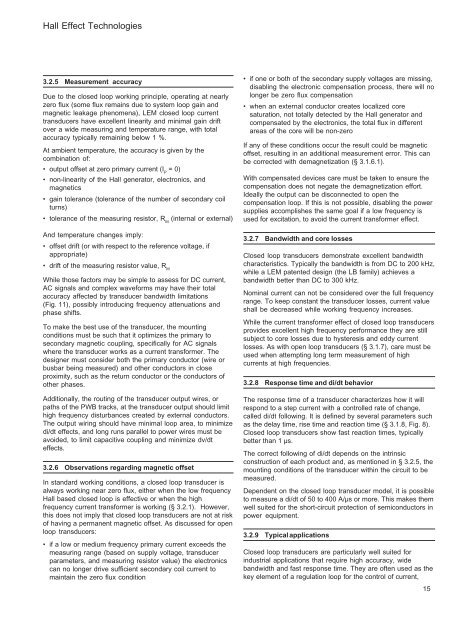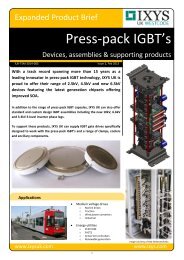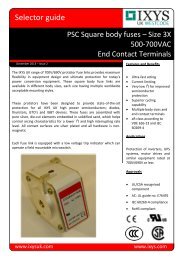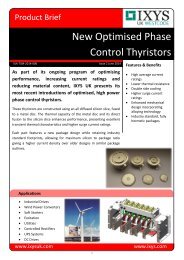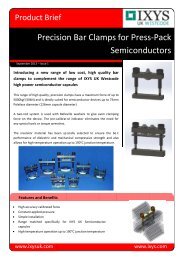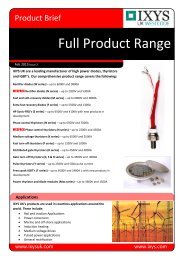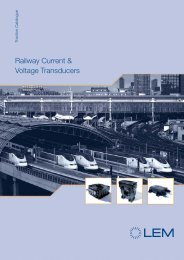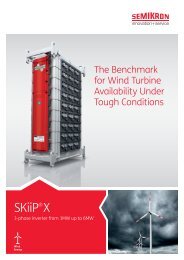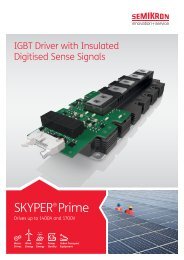isolated current voltage transducers
Create successful ePaper yourself
Turn your PDF publications into a flip-book with our unique Google optimized e-Paper software.
Hall Effect Technologies<br />
3.2.5 Measurement accuracy<br />
Due to the closed loop working principle, operating at nearly<br />
zero flux (some flux remains due to system loop gain and<br />
magnetic leakage phenomena), LEM closed loop <strong>current</strong><br />
<strong>transducers</strong> have excellent linearity and minimal gain drift<br />
over a wide measuring and temperature range, with total<br />
accuracy typically remaining below 1 %.<br />
At ambient temperature, the accuracy is given by the<br />
combination of:<br />
• output offset at zero primary <strong>current</strong> (I P<br />
= 0)<br />
• non-linearity of the Hall generator, electronics, and<br />
magnetics<br />
• gain tolerance (tolerance of the number of secondary coil<br />
turns)<br />
• tolerance of the measuring resistor, R M<br />
(internal or external)<br />
And temperature changes imply:<br />
• offset drift (or with respect to the reference <strong>voltage</strong>, if<br />
appropriate)<br />
• drift of the measuring resistor value, R M<br />
While those factors may be simple to assess for DC <strong>current</strong>,<br />
AC signals and complex waveforms may have their total<br />
accuracy affected by transducer bandwidth limitations<br />
(Fig. 11), possibly introducing frequency attenuations and<br />
phase shifts.<br />
To make the best use of the transducer, the mounting<br />
conditions must be such that it optimizes the primary to<br />
secondary magnetic coupling, specifically for AC signals<br />
where the transducer works as a <strong>current</strong> transformer. The<br />
designer must consider both the primary conductor (wire or<br />
busbar being measured) and other conductors in close<br />
proximity, such as the return conductor or the conductors of<br />
other phases.<br />
Additionally, the routing of the transducer output wires, or<br />
paths of the PWB tracks, at the transducer output should limit<br />
high frequency disturbances created by external conductors.<br />
The output wiring should have minimal loop area, to minimize<br />
di/dt effects, and long runs parallel to power wires must be<br />
avoided, to limit capacitive coupling and minimize dv/dt<br />
effects.<br />
3.2.6 Observations regarding magnetic offset<br />
In standard working conditions, a closed loop transducer is<br />
always working near zero flux, either when the low frequency<br />
Hall based closed loop is effective or when the high<br />
frequency <strong>current</strong> transformer is working (§ 3.2.1). However,<br />
this does not imply that closed loop <strong>transducers</strong> are not at risk<br />
of having a permanent magnetic offset. As discussed for open<br />
loop <strong>transducers</strong>:<br />
• if a low or medium frequency primary <strong>current</strong> exceeds the<br />
measuring range (based on supply <strong>voltage</strong>, transducer<br />
parameters, and measuring resistor value) the electronics<br />
can no longer drive sufficient secondary coil <strong>current</strong> to<br />
maintain the zero flux condition<br />
• if one or both of the secondary supply <strong>voltage</strong>s are missing,<br />
disabling the electronic compensation process, there will no<br />
longer be zero flux compensation<br />
• when an external conductor creates localized core<br />
saturation, not totally detected by the Hall generator and<br />
compensated by the electronics, the total flux in different<br />
areas of the core will be non-zero<br />
If any of these conditions occur the result could be magnetic<br />
offset, resulting in an additional measurement error. This can<br />
be corrected with demagnetization (§ 3.1.6.1).<br />
With compensated devices care must be taken to ensure the<br />
compensation does not negate the demagnetization effort.<br />
Ideally the output can be disconnected to open the<br />
compensation loop. If this is not possible, disabling the power<br />
supplies accomplishes the same goal if a low frequency is<br />
used for excitation, to avoid the <strong>current</strong> transformer effect.<br />
3.2.7 Bandwidth and core losses<br />
Closed loop <strong>transducers</strong> demonstrate excellent bandwidth<br />
characteristics. Typically the bandwidth is from DC to 200 kHz,<br />
while a LEM patented design (the LB family) achieves a<br />
bandwidth better than DC to 300 kHz.<br />
Nominal <strong>current</strong> can not be considered over the full frequency<br />
range. To keep constant the transducer losses, <strong>current</strong> value<br />
shall be decreased while working frequency increases.<br />
While the <strong>current</strong> transformer effect of closed loop <strong>transducers</strong><br />
provides excellent high frequency performance they are still<br />
subject to core losses due to hysteresis and eddy <strong>current</strong><br />
losses. As with open loop <strong>transducers</strong> (§ 3.1.7), care must be<br />
used when attempting long term measurement of high<br />
<strong>current</strong>s at high frequencies.<br />
3.2.8 Response time and di/dt behavior<br />
The response time of a transducer characterizes how it will<br />
respond to a step <strong>current</strong> with a controlled rate of change,<br />
called di/dt following. It is defined by several parameters such<br />
as the delay time, rise time and reaction time (§ 3.1.8, Fig. 8).<br />
Closed loop <strong>transducers</strong> show fast reaction times, typically<br />
better than 1 µs.<br />
The correct following of di/dt depends on the intrinsic<br />
construction of each product and, as mentioned in § 3.2.5, the<br />
mounting conditions of the transducer within the circuit to be<br />
measured.<br />
Dependent on the closed loop transducer model, it is possible<br />
to measure a di/dt of 50 to 400 A/µs or more. This makes them<br />
well suited for the short-circuit protection of semiconductors in<br />
power equipment.<br />
3.2.9 Typical applications<br />
Closed loop <strong>transducers</strong> are particularly well suited for<br />
industrial applications that require high accuracy, wide<br />
bandwidth and fast response time. They are often used as the<br />
key element of a regulation loop for the control of <strong>current</strong>,<br />
15


